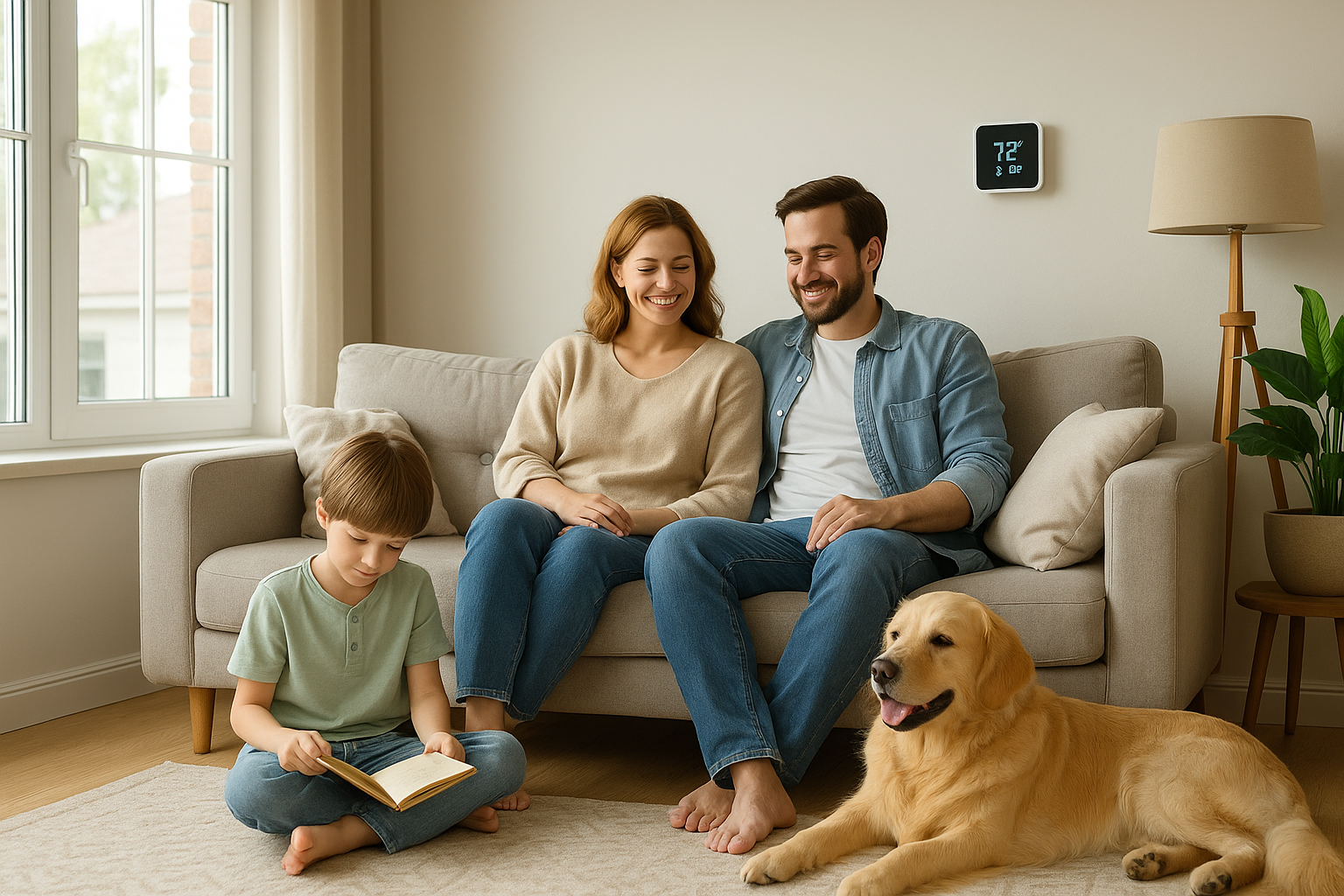Maintaining the right level of indoor humidity impacts health, energy efficiency, and the longevity of your home. A well-tuned system plays a key role of HVAC in humidity control, reducing the risk of mold, protecting wood surfaces, and improving indoor air quality. At Leaps & Bounds, we bring decades of experience serving Camp Hill, PA, to help families achieve consistent comfort all year long.
Below, you’ll learn how HVAC systems manage indoor humidity, the solutions available for different needs, the signs you may need professional help, and the steps you can take to keep your home’s air balanced.

How HVAC Systems Manage Indoor Humidity
The role of HVAC in humidity control extends beyond heating and cooling. Whether it’s the sticky heat of summer or the dry chill of winter, your system works to maintain proper indoor moisture levels.
In cooling mode, your air conditioner or heat pump pulls warm, humid air into the system. As the air passes over the cooling coils, moisture condenses and drains away through the condensate line. This process helps prevent dampness that can lead to mold growth or swelling in wood surfaces.
In winter, furnaces and heat pumps often lower indoor humidity as they heat the air. While this can reduce excess moisture, it can also create overly dry conditions. That’s where a whole-home humidifier comes in, adding the right amount of moisture to keep your home comfortable and protect wood floors, furniture, and musical instruments.
Modern HVAC systems can also be paired with smart thermostats and humidity sensors for precise humidity control, helping to reduce allergens, control dust mites, and prevent respiratory discomfort.
Common Solutions for HVAC Humidity Control
Not every home requires the same humidity management approach. Your climate, home design, and comfort preferences all influence the right choice.
Heat Pumps
Heat pumps both heat and cool, making them a versatile option for year-round humidity control. In summer, they operate like an air conditioner, removing excess moisture along with heat. In winter, they can cause dryness, so many homeowners pair them with a whole-home humidifier.
Furnaces
Gas or oil furnaces provide powerful winter heat but can dry out indoor air. This dryness may cause static shocks, dry skin, and cracks in woodwork. Adding a built-in humidifier is a common solution for keeping moisture levels in the optimal range.
Ductless Mini Splits
For homes without central ductwork or room-specific needs, ductless mini-splits offer both heating and cooling. Many models allow you to set both temperature and humidity for individual zones, using variable-speed compressors and smart sensors to adapt to changing indoor conditions.
At Leaps & Bounds, we help homeowners choose the right system for their home’s layout and comfort goals, ensuring humidity control is part of the equation from the start.
Signs Your Home May Need Professional Humidity Management
Recognizing early warning signs of poor humidity control can help you avoid damage and discomfort.
Too Much Moisture:
-
Condensation on windows
-
Musty odors
-
Visible mold or damp spots on walls and ceilings
-
Swelling or warping of wood furniture or floors
Too Little Moisture:
-
Dry skin, throat irritation, or coughing
-
Cracked wood trim or flooring
-
Peeling wallpaper or paint
Even pets and plants can be affected. If your cat is scratching more than usual or your houseplants are wilting despite regular care, the humidity balance may be off. Portable humidifiers or dehumidifiers can help temporarily, but for long-term comfort, a whole-home solution is often more effective.
Practical Maintenance Tips for Balanced Humidity
Maintaining your HVAC system helps it manage humidity efficiently.
-
Replace Air Filters Regularly
Dirty filters restrict airflow, reducing your system’s ability to control humidity. Replace them every 1–3 months. -
Clean the Condensate Drain Line
After heavy cooling use, ensure the drain line is clear to prevent water backups and mold growth. -
Inspect Built-In Humidifiers
Clean and check for mineral buildup or mold at least once a season to keep moisture levels consistent. -
Schedule Annual Professional Service
A trained technician can catch small issues, like refrigerant leaks, worn blower belts, or faulty humidity sensors, before they become bigger problems. -
Consider Smart Upgrades
Smart thermostats and integrated humidity systems provide detailed readings and automated adjustments, keeping conditions ideal year-round.
Why Proper Humidity Control Matters
Balanced humidity helps you feel comfortable, and it protects your home and health. Proper levels help:
-
Reduce the spread of airborne viruses and bacteria
-
Protect wood furniture, floors, and musical instruments
-
Improve sleep quality and breathing comfort
-
Lower energy bills by allowing you to feel comfortable at a wider temperature range
For most homes, ideal indoor humidity ranges between 30% and 50%. The exact range depends on the season and your personal comfort level.
Professional Support for Year-Round Comfort
Whether your home feels muggy in July or too dry in January, Leaps & Bounds HVAC can help. Our team specializes in diagnosing humidity issues and recommending tailored solutions, from system upgrades to fine-tuned adjustments.
Serving Camp Hill, PA, and the surrounding area, we provide maintenance, repairs, and installations designed to keep your home comfortable and healthy in every season.
If you’re ready to enjoy consistent comfort and protect your home from the effects of poor humidity control, contact Leaps & Bounds HVAC today. Our experienced technicians are here to help you achieve the perfect indoor environment, all year long.


